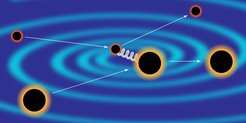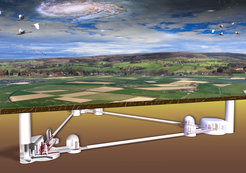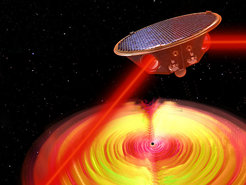Collaboration between gravitational-wave astronomy and particle physics established

“Powerful theoretical methods for predicting results of scattering processes involving elementary particles, such as those observed at the Large Hadron Collider at CERN, are now also being applied to the modeling of gravitational waves from astronomical binary systems,” says Dr. Justin Vines, who for the next four years will bring the two research topics at the AEI and UCLA under one roof. While gravitational-wave astronomers are announcing one spectacular discovery after the next, they are also thinking about how to measure the signals and interpret the data from the increasingly sensitive detectors in the future. “The more sensitive the gravitational-wave detectors become, the more accurately we’ll have to model the waveforms used to search for and analyze the signals,” explains Alessandra Buonanno, in whose department at the AEI Justin Vines will conduct research over the next two years before moving to UCLA. “Using advanced techniques from quantum field theory, we now want to refine the calculation of the waveform models even further,” adds the director at the AEI and College Park professor at the University of Maryland. “The prospect of quantum scattering amplitude calculations having a direct impact on gravitational-wave science is a truly exciting one for both sides, and we look forward to continuing to push the frontiers of theoretical knowledge of classical gravitational dynamics in our collaboration with the AEI,” says Zvi Bern, director of the Mani Lal Bhaumik Institute for Theoretical Physics at UCLA.
Scattering amplitudes for gravitational-wave modeling

Dr. Justin Vines will serve as a bridge between the groups at the AEI and UCLA, fostering collaborations with long-term visits between the two institutions. It has only relatively recently been realized that certain theoretical technology from the field of quantum scattering amplitudes (e.g. generalized unitarity and double-copy constructions) can be fruitfully applied to the classical relativistic two-body problem. In continuing this process, physicists face not only technical challenges but also some potentially deep conceptual questions, for example, concerning a formal correspondence between ‘minimally coupled’ higher-spin quantum particles and classical spinning black holes.

“Coming from a background in classical gravity, I still have much to learn myself about the great strides made in recent decades in constructing and understanding scattering amplitudes in relativistic quantum theories. I look forward to doing so by working closely with the UCLA group as well as the AEI group. There’s clear potential for both sides to learn a great deal from one another, and the contact with classical gravity may even lead to new insights of intrinsic value to the study of quantum gravitational interactions,” says Justin Vines.














